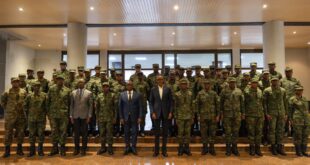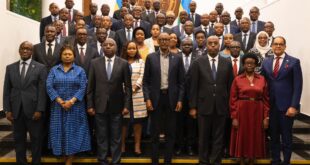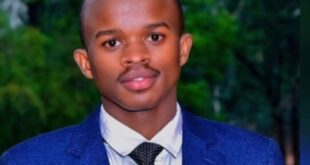By: Ambassador Adonia Ayebare
The graveyards of the world are full of indispensable men,” Charles De Gaulle, former president of France, said about legacy of leaders. The death of Pierre Nkurunziza, 55, formerly president of Burundi, reminded me of De Gaulle’s words.
The Nkurunziza was not indispensable. I met him in 2004 during the Burundi peace talks in Dar-es Salam, Tanzania, where he led the delegation of then rebel movement CNDD-FDD in talks with former presidents Pierre Buyoya and Domitien Ndayizeye.
The leadership style of chairman Nkurunziza was fascinating. He insisted on all the members of his delegation attending all the meetings and consultations.
This approach of Nkurunziza being accompanied by all members of his entourage was a nightmare for mediators, as Nkurunziza insisted on each member of his delegation taking to the floor, which often led to divergent positions. It became clear that he wanted to bring everybody on board to avoid the impression that he was indispensable.
The leadership of CNDD-FDD was of the same generation, which was a challenge in itself, testing Nkurunziza’s leadership credentials. Senior cadres included Rajab Hussein, Gen Silas Ntigurigwa, Gen Adolf Nshimirimana, and the newly elected president, Evariste Ndayishimiye.
Overruled Nkurunziza
Of all these, Rajab, the former CNDD-FDD secretary general, wielded more power, and in some instances overruled Nkurunziza on key issues, like the composition of future security forces and power sharing arrangements.
Despite the apparent challenge to his power by Rajab, both during the negotiations and when CNDD took over power in 2005, Nkurunziza always crossed ranks and maintained unity. It was only when Rajab made governing effectively impossible that Nkurunziza got rid of him, which he did by mobilising senior members of the party.
Nkurunziza told me that the door for Rajab to return to the party ranks was always open so long as he respected the hierarchy of the party.
The Burundi peace talks were very protracted, starting in 1996 after Buyoya returned to power in a coup following the political turmoil that claimed thousands of lives after the murder of the first elected president, Melchior Ndadaye by the army in 1993.
The talks began in 1996 with then Tanzania president Julius Nyerere as facilitator and President Museveni of Uganda as the chair of the regional peace initiative on Burundi.
Nyerere’s approach was to work with parties that had participated in the 1993 contest, which were FRODEBU (dominated by Hutu that had won the 1993 elections); UPRONA (dominated by Tutsi with links to the then government army); and a couple of other Hutu and Tutsi parties. Nyerere believed that FRODEBU represented Hutu interests, including the armed groups like CNDD-FDD, and was focused on an agreement between political actors.
When Nelson Mandela took over after the death of Nyerere as the facilitator of the Burundi peace process, he embarked on bringing in all armed groups, including Nkurunziza’s CNDD-FDD. At the time of joining the peace talks, CNDD-FDD was led by Jean-Bosco Ndayikengurukiye, who Nkurunziza toppled as the talks progressed.
Nkurunziza’s seizure of CNDD-FDD, the largest rebel movement, was precipitated by internal divisions within the movement over the centralised leadership styles of his two predecessors, Nyagoma and Ndayikengurukiye. The rank and file, in particular, detested lack of feedback from the leaders.
Nkurunziza learnt from the toppling of his predecessors that nobody was indispensable in CNDD-FDD, and instituted a collegial leadership style that enabled him to skilfully go through the peace talks, the transitional government where he served as number three in government, and eventually winning the elections and being sworn as president in 2005.
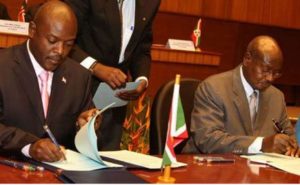
From the onset, Nkurunziza’s presidency was faced with the twin problems of implementing the Arusha agreement and ending the war by negotiating with FNL-Palipehutu, the remaining armed group which was led by Agathon Rwasa, the current opposition leader. His first priority was to convince the senior leadership of CNDD-FDD of the need to end the FNL-Palipehutu insurgency through negotiations.
The initial alliance between FNL-Palipehutu and CNDD-FDD to fight the regime in Bujumbura broke down due to differences over which movement was authentic in fighting for the rights of majority Hutu people.
Aware of these tensions Nkurunziza, appointed Gen Evariste Ndayishimiye as the lead negotiator because of his prior experiences. I went along with senior officials from Tanzania and South Africa to assist the facilitator, Mr Charles Nqakula from South Africa. The talks between CNDD and FNL were fraught with tension and were called off more than five times due to suspicions among people who knew each other well. Generals around Nkurunziza called for outright military victory, while the president called for patience.
In 2008, a peace deal was reached after the region pressured FNL-Palipehutu to join the state. Nkurunziza realised early that Rwasa was going to be his main future rival and made overtures ahead of the 2010 elections. After the polls the FNL joined parliament and legitimised the process.
The CNDD-FDD, Nkurunziza’s party, had tried to fight any reference to the Arusha agreement, which was signed in 2002 before they joined the peace process, arguing that it did not recognise them. The regional leaders, led by President Museveni convinced the CNDD that the Arusha accord addressed their political concerns and that only a ceasefire needed to be signed. The position of the region almost split the movement as the hard-line wing argued that they would look weak to end a political agreement agreed upon by their rivals. Again, Nkurunziza asked the region to give them time so that he could bring the dissenters on board.
As the talks between the CNDD -FDD and the transitional government led by Domitien Ndayizeye faltered amid flaring tempers, regional leaders asked President Museveni to directly assist the facilitator, Jacob Zuma, then deputy president of South Africa. Ndayizeye’s of FRODEBU party was despised by Nkurunziza’s CNDD-FDD as sell-outs to the “people’s cause”.
President Museveni asked me to be his personal advisor on the peace process, a task which involved working with President Nkurunziza and his colleagues on their concerns, and also advising Zuma.
Uganda was asked by regional leaders to provide travel documents to Nkurunziza and his rebel colleagues so they would travel for consultations around the region. To avoid suspicion, the CNDD -FDD leaders were asked to choose Ugandan names. Nkurunziza chose Sula Kato, who was his favourite soccer player in Uganda, having seen him score a wonder goal against the Burundi national team.
Nkurunziza and his colleagues made numerous trips to Uganda to meet the President, who was using the experience of past reconciliation efforts in Uganda, especially the integration of former government armies into UPDF to form a formidable force. This convinced Nkurunziza and his colleagues to sign a ceasefire and join the transitional government, which led to the 2005 peaceful elections and end of the transitional period.
It was ironic that the Arusha agreement, which Nkurunziza and his colleagues had vehemently criticised, saved them in the 2015 political crisis that led to massive violence and an aborted military coup. The crisis was sparked off by an attempt to change the constitution to run for what the opposition called an illegal third term, but his supporters called legitimate.
The Constitutional Court of Burundi ruled that Nkurunziza was not barred from standing for another term, which would be his last. The court reasoned: “To understand the spirit of the constitution, it is useful to first understand the document which mostly inspired the drafters of the 2005 constitution, the Arusha Agreement.”
Final meeting
The last time I met Nkurunziza was last year in February, at his county home in the beautiful hills of Ngozi to the north of Burundi. We talked about the challenges facing East Africa, and Burundi in particular. I asked about his achievements and failures as president. Typical of him, Nkurunziza paused for two minutes before answering me: “Adonia, you remember when you came to visit me here in 2015, a week after I returned from Tanzania to suppress a military coup and assassination of our people were taking place on a daily basis, and the country was literally on fire? My main achievement has been the restoration of peace and security across Burundi.” I pressed him on his failures. He raised his eyes and said, “The economy, Burundi’s economy is in bad shape as well as the health sector.”
Nkurunziza’s legacy will be setting in motion a peaceful succession plan. He died after the election of his friend and long-term comrade, Gen Evariste Ndayishimiye, as his successor.
“He (Nkurunziza) is our hero; he has left us in good standing,” new president Gen Neva, as his friends fondly call him, told me.
The writer is Uganda’s Permanent Representative to the United Nations
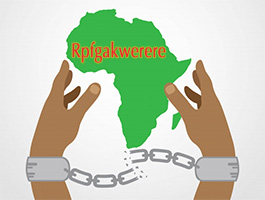 Africa Just another WordPress site
Africa Just another WordPress site
